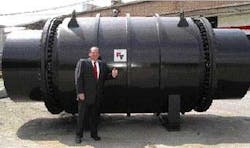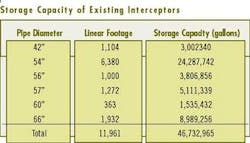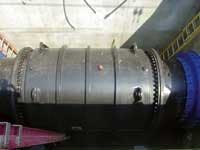Large Diameter Pinch Valve Used to Store Stormwater in Sewer Line
Historically, the processing of wastewater was focused on simply collecting sewage and pumping it to the local wastewater treatment plant for processing. Under normal, dry weather conditions, sewage would flow directly into the wastewater treatment plant. There were no provisions for handling stormwater; it was allowed to discharge freely into waterways.
Later, the U.S. Environmental Protection Agency restricted the free flow of stormwater and required that the first 10% of rain water be captured and treated. This resulted in larger pipelines where sewage was combined with stormwater and piped to the wastewater treatment plant for processing.
Combined sewer systems were sized to handle all of the normal sewage flow through the line and the first 10% of rainfall. The thinking at the time was that if the treatment plant could handle the normal sewage load and the first 10% of rain fall, there would be little or no impact on the environment. The thinking was, that if all of the excess flow was relatively clean or very diluted, it could simply overflow into the receiving waterway.
Since then, engineers have learned that overflow events cause beach closings, river contamination, damage to the environment, sickness, and in severe cases, death. Today, there is legislation to eliminate combined sewer overflows. Heavy fines are levied by the EPA against communities that violate this law. The EPA has been reasonable with enforcement because the costs associated with eliminating combined sewer overflows is so great and it will take time to expand the infrastructure.
When an overflow event occurs, the municipality or utility is fined quite heavily. The fines most often are held in escrow and made available to the municipality or utility to fund combined sewer overflow elimination projects.
However, as municipalities and utilities have learned, eliminating overflow events is a must.
There are a number of ways to eliminate combined sewer overflow events. These include building a new wastewater treatment plant, expanding an existing plant, build a deep tunnel to capture stormwater, installing inflatable dams in the interceptor, building flow equalization or retention basins to handle peak flows, or better use the storage capacity of the existing collection system.
A large Midwest city reviewed these options and decided to use the capacity of its collection and interceptor system for stormwater storage and to regulate or divert flow to minimize or eliminate overflow events.
Calling on the expertise of a major engineering firm, a control strategy was identified that would minimize combined sewer overflow volume and frequency through the optimization of the collection and treatment system.
To accomplish these goals, Triad Engineering Inc. designed a system that uses Type A Megaflex pinch valves manufactured by Red Valve Co. to regulate and or divert flow to portions of the pipeline network that have storage capacity. The design calls for a 72-inch and 66-inch pinch valves.
By modulating the inflation pressure of the 72-inch valve, the city has the ability to use approximately 11,900 linear feet of interceptors that range in size from 42 inches to 66 inches. The total storage capacity of these interceptors is 46,732,965 gallons.
Monitoring devices located throughout the network of collection pipelines send flow data via telemetry to a central control station. In turn a control signal is sent to one of the Megaflex valves to partially close the valve. Modulating or partially closing the pinch valve regulates or diverts the flow into underused portions of the collection system for storage or sends the flow to a treatment plant with available capacity.
This system reduces the volume of overflows at 15 locations. Computer modeling of the system shows that in a 1-inch rainfall event, modulating the system with the 72" pinch valve will save 6 million gallons from overflowing, or 240 million gallons in one year based on an average of 40 inches of rain per year. With the 66-inch valve installed, the modeling shows that an additional 480 million gallons will be saved from overflow.
In selecting the Megaflex pinch valves, the city required that the valves were to be retrofitted into the existing interceptors with no loss of conveyance capacity. And, that the installation would require a minimum of bypass pumping.
The pinch valve vault and the control structure were built around the interceptor. When the valve was delivered, the contractor cut away a section of the existing interceptor and slipped the valve in place. The valve was supplied with spool pieces to facilitate this process. The installation required about 12 hours of bypass pumping.
The Type A Megaflex was selected for this system because the full line size valves are like a straight piece of pipe when open and the partial closing capability of these valves provided the ability to isolate or control the flow.
For more information on Red Valve's line of pinch valves, check valves, knife gate valves, pressure sensors, air diffusers and rubber products, visit the company's Web site at www.redvalve.com.



